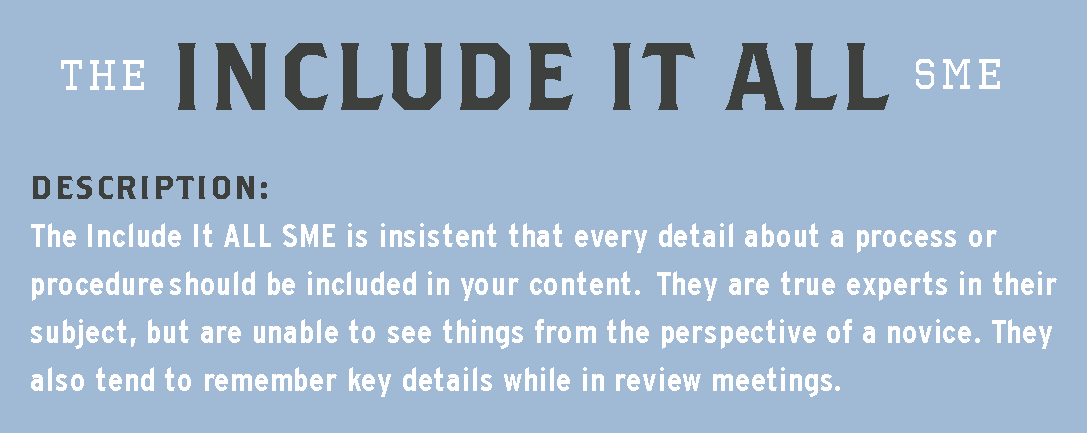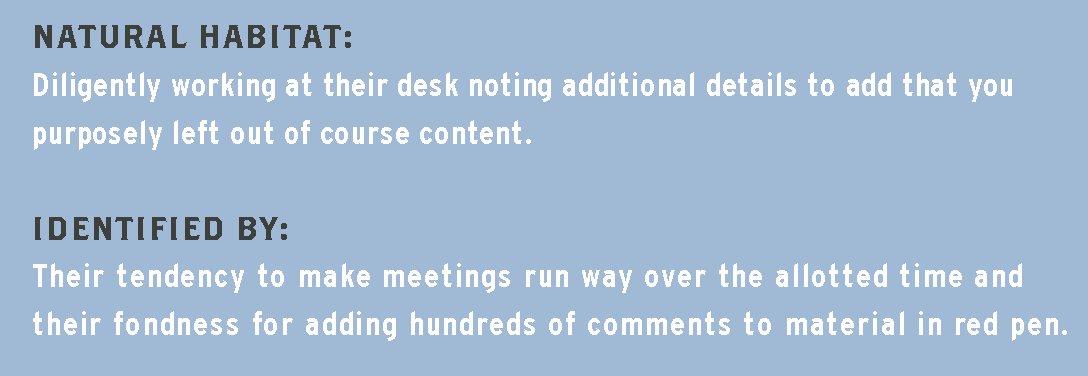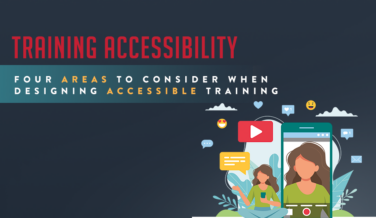How To Convince Your Subject Matter Expert That Less Is More
by Andrea May
Working with subject matter experts is not a straight-forward, one-size-fits-all affair. There’s no rulebook with a single set of rules on SME project management that works for every SME you’ll encounter. Instead, each SME presents a unique challenge for instructional designers and other L&D professionals. But, before you can work with a SME effectively, you must identify what type of SME they are. Figuring that out involves determining their priorities and the biases they hold regarding teaching others about their area of expertise.
One of our seven SME archetypes, the “Include-It-All” SME, can be especially troublesome for instructional designers, particularly new or inexperienced ones. The “Include-It-All” SME is a true expert in their chosen field. They know all there is to know about a specific software, or whatever happens to be their niche. Their schemas and mental models are highly developed and, as such, they have difficulty separating the “need-to-know” from the “nice-to-know” when it comes to the process of imparting a new learner with their vast knowledge and wisdom.

When working with an instructional designer to develop material for a new learner, these SMEs can be very insistent that everything they know is important, and thus, should be included in the material. It’s practically impossible for this SME to break down their well-defined schema into its component parts. A question we received from an attendee of one of our Seven SME Archetypes sessions reflects this problem:
“I think the issue we run into, and I’m sure many others do as well, is it is very difficult to convince the SMEs that shoving all the information into a learning isn’t the best approach. They think that without the background information, people will get lost and confused, when in fact they just don’t care about 30 new processes and procedures you shoved down their throat.
What I’d love to see is how you handle that crucial step of persuading them to ‘see the light,’ that one or two key concepts are better than ALL of them.”
What is the solution to this dilemma? Neither your budget, nor your learners can handle the “everything AND the kitchen sink” course that this SME wants, and we know that is not a workable solution anyway. Going behind a SMEs back by cutting out extra content after the final review is also not advisable. They are, after all, the SME and what if you cut something that is critical? Not to mention that it’s a bit underhanded and frowned upon to take that approach.
So, what option are you left with? Well, you’ll need some convincing arguments, like andragogy, cognitive overload, and chunking.

A is for Andragogy
Andragogy, a theory of adult learning proposed by educator Malcolm Knowles, provides the first several arguments against putting everything a SME knows into a course. Knowles suggested four principles of andragogy that describe how adults learn.
- Adults need to know why they are learning something.
- Adults learn through problem-solving.
- Adults learn through doing.
- Adults learn when the knowledge is of immediate use.
If we consider each of these principles in the context of training development, they all point to the development of learning experiences that are highly focused on what a learner needs to be able to do by the conclusion of the training. The learning must be goal-oriented, and provide “just enough, just in time” information to achieve those goals. Information that does not support the completion of a goal or task does not belong in the course.
By contrast, the SME’s approach of “including-it-all” undermines the principles of andragogy with page after page of information that is of no immediate use to the learner and extends far beyond the scope of what the learner needs to be able to do when the course has finished.
Knowles’ principles can be used by instructional designers and SMEs as a sort of litmus test to determine what information is truly critical to achieving stated learning objectives.

Cognitive Overload is Real
As humans, our working memory is only designed to handle approximately four to eight pieces of information at any given time. Learning is the process of assigning meaning or relative position to each new piece of information and integrating it into existing or newly forming mental schemas. In this way, new pieces of information are moved from our limited working memory into our long-term memory where it can be readily accessed when needed.
But what happens when we are bombarded with too much information all at once? The resulting cognitive overload can potentially have any, or all, of the following results:
- Decreased productivity
- Reduced focus and attention span
- Frustration
- Boredom
- Increased error rate
- Delayed decision making
- Loss of job satisfaction
- Ill health
As you can see, cognitive overload is not a pleasant state of being. And, it greatly reduces our ability to move information from working memory to long-term memory which is opposite of what we want to see happening in a learning situation.
As instructional designers, we can help learners avoid cognitive overload by making sure to only include information in course materials that is directly related to an experiential learning activity. Your SME can, and should, be involved in helping you to design activities that promote decision-making over recalling facts. This approach makes it clear what information is essential for the learner and what information is merely nice to know.

The Power of Chunking
By now your SME may already be convinced that less is better when it comes to choosing the information to include in a course. But, if they are not yet on board, or worse, if they continue to insist on including too much information in the course, I give you chunking.
Chunking is a powerful tool in the instructional design arsenal that helps you organize content into bite-size pieces and logically group like information to effectively utilize short-term memory. Essentially, chunking helps in the learning process by breaking large volumes of information into small chunks that are easier to remember.
We can see evidence of how effective chunking can be in terms of learning and retention by looking at a simple telephone number.
|
A telephone number is rarely seen written this way: |
16123384911 |
|
Instead, we chunk the information to make it easier to remember: |
1-612-338-4911 |
The chunking process consists of several steps. Depending on the type of information you are chunking, you may use all of these steps or just a couple of them. To chunk a long string of information, do the following:
- Break large pieces of information into smaller units
- Identify similarities or patterns within or among units of information.
- Organize the information logically.
- Group information into manageable units using techniques such as bulleted lists.
Information chunked appropriately can help the learner focus on important points, increase retention, and facilitate the integration of the new information into their existing mental schemas. The learners and your SME will thank you.
Final Thoughts
Working with SMEs comes with hurdles, and the “Include-It-All” SME can certainly present a challenge for an instructional designer, who may be seen by the SME as the evil taskmaster who wants to ruthlessly cut away precious content that may never be seen again. But the instructional designer is not without strategies to win the SME over to their way of thinking. By showing the SME how the principles of andragogy and the power of chunking can work together to defeat cognitive overload in the learners, the ID and the SME can work together to create meaningful learning experiences that engage the learner and achieve the learning objectives.
Continue reading

Dashe joins ttcInnovations
Learn More
Embracing the Future: Early Adopters of Generative AI for Learning
Learn More
Four Areas To Consider When Designing Accessible Training
Learn MoreCommitted to
finding solutions
